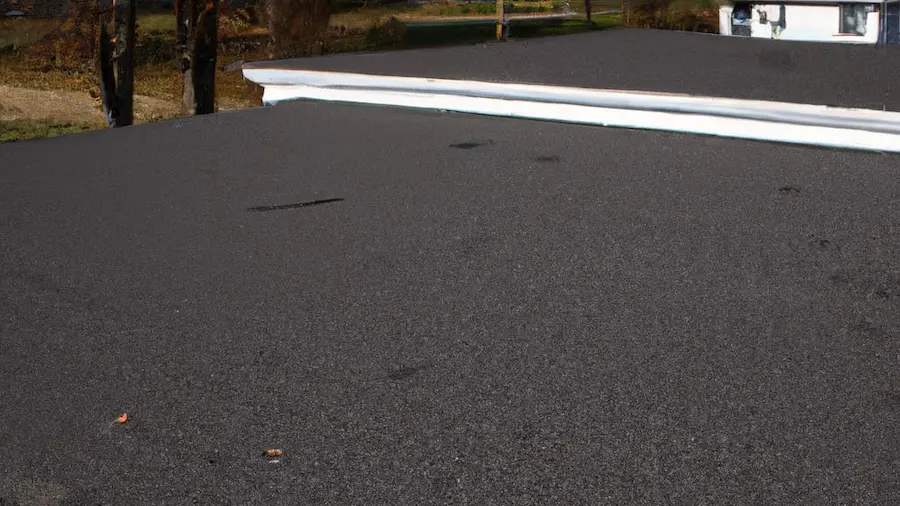~ 5 min read
The [Best] Flat Roof Materials: Pros & Cons - Lifespan & Costs

Homeowners in certain parts of the country—primarily on the coasts—are accustomed to living in places where flat roofs are the norm.
In areas where high winds, heavy rainfall, and lots of sun are expected, flat roofs are the best option for keeping the rain out of your home. Flat roofs are easy to install and are much less expensive than peaked roofs.
However, flat roofs have some drawbacks, including that they’re prone to leaks and must be replaced more frequently than peaked roofs. While some flat roofing options are long lasting, they’re also significantly more expensive than others, like asphalt shingles.
What are the different types of flat roofs?
Many materials fall under the category of flat roofing materials. The most common type is a rubber roof, made from synthetic rubber, known as EPDM. Single-ply roofs are also standard. These are made from a single layer of material, usually synthetic rubber, which means they are easy to install, but they only offer a limited lifespan.
PVC (Polyvinyl Chloride) roofing is another standard option, sometimes called a membrane roof. PVC roofing is made from two sheets bonded together with a layer of PVC in the middle. Modified bitumen roofing, sometimes referred to as mod bit roofing, is the type of flat roofing we are most commonly aware of in the UK.
This type of roofing is created from a single layer of bitumen placed on a decking material, which is sometimes reinforced with a mat or mesh and has a gravel surface.
What are the benefits of a flat roof?
The main benefit of flat roofs is that they are easy and inexpensive to install. The flat roof does not have the complexity of a sloped roof and does not require the same amount of materials or the same level of expertise. Flat roofs are also simpler to waterproof because the membrane sits on the roof deck without needing to be tipped or edged up along the walls.
But the main advantage of a flat roof is that we can use it for almost any purpose. For example, green roofs are flat roofs covered in growing medium and vegetation. Roof gardens installed with exceptional insulation, drainage, and snow melting systems can be flat roofs too.
Since you can install flat roofs on almost any building, they are great for commercial applications. Commercial buildings have large, continuous roof areas and often have larger budgets than domestic projects.
Flat roofs are also very energy efficient. Simple roof decks can provide insulation and help keep a building cool in summer and winter.
How much should I budget for a flat roof?
A simple built-up roof on a simple low-pitch roof should cost around $50 per square foot. A simple built-up roof on a complex low-pitch roof will cost more, and a complex built-up roof will cost more still.
It is possible to buy a modified bitumen roof for as low as $2 per square foot. It is also possible to pay $40 per square foot or more for a modified bitumen roof. You can expect to pay $10 to $15 per square foot for a PVC roof and $20 to $30 per square foot or more for a metal roof.
Roof coatings can make sense on flat roofs and can be surprisingly affordable. Coating a simple flat roof, you can pay $1 to $2 per square foot. Covering a complex flat roof, you can pay $2 to $4 per square foot or more.
Should you repair or replace your flat roof?
When a part of the flat roof is damaged, it is usually best to repair that section. If the entire roof has become damaged, then it is usually best to replace the whole roof.
But if the flat roof is a metal roofing system, it is a good idea to repair the damage rather than replace the entire roof. Metal roofing systems are more expensive than traditional and heavier, so installing a new metal roof is more challenging and time-consuming than installing a new one made from other materials.
If the roof structure is in good condition and the usable space is not too small, replacing the roof can be a good option. The roof will match the rest of the house, and the entire structure will be watertight. It will provide a strong, sturdy, and functional roofing system.
A rubber roof membrane covers most flat roofs. You should replace this roof only if the entire structure is damaged. Removing a rubber roof membrane is a tricky process that requires special equipment, and the whole roof membrane is not usually reusable.
When choosing the best roofing material for a flat roof, there are many things to consider. The pros and cons of each type of roofing material and the lifespan and costs are all essential factors to keep in mind. Ultimately, the best roofing material for a flat roof depends on the specific needs and budget of the homeowner.
Related Reading: